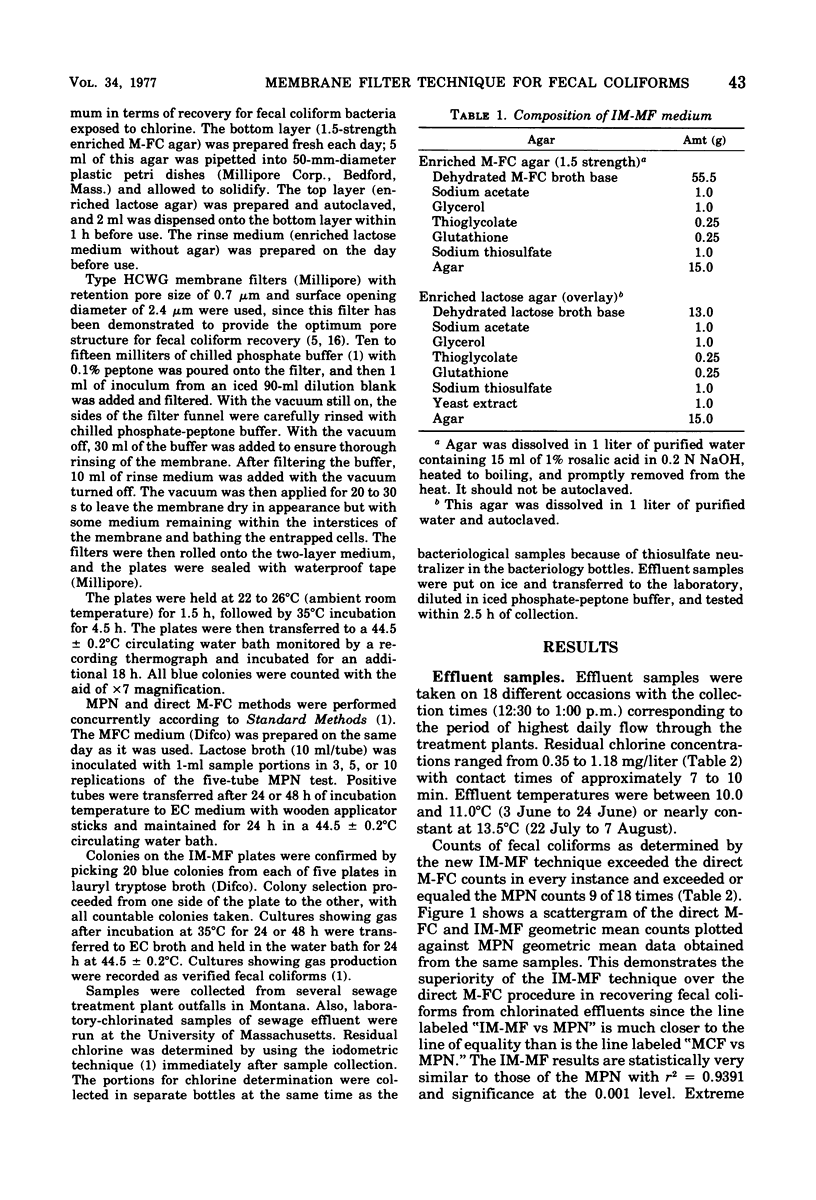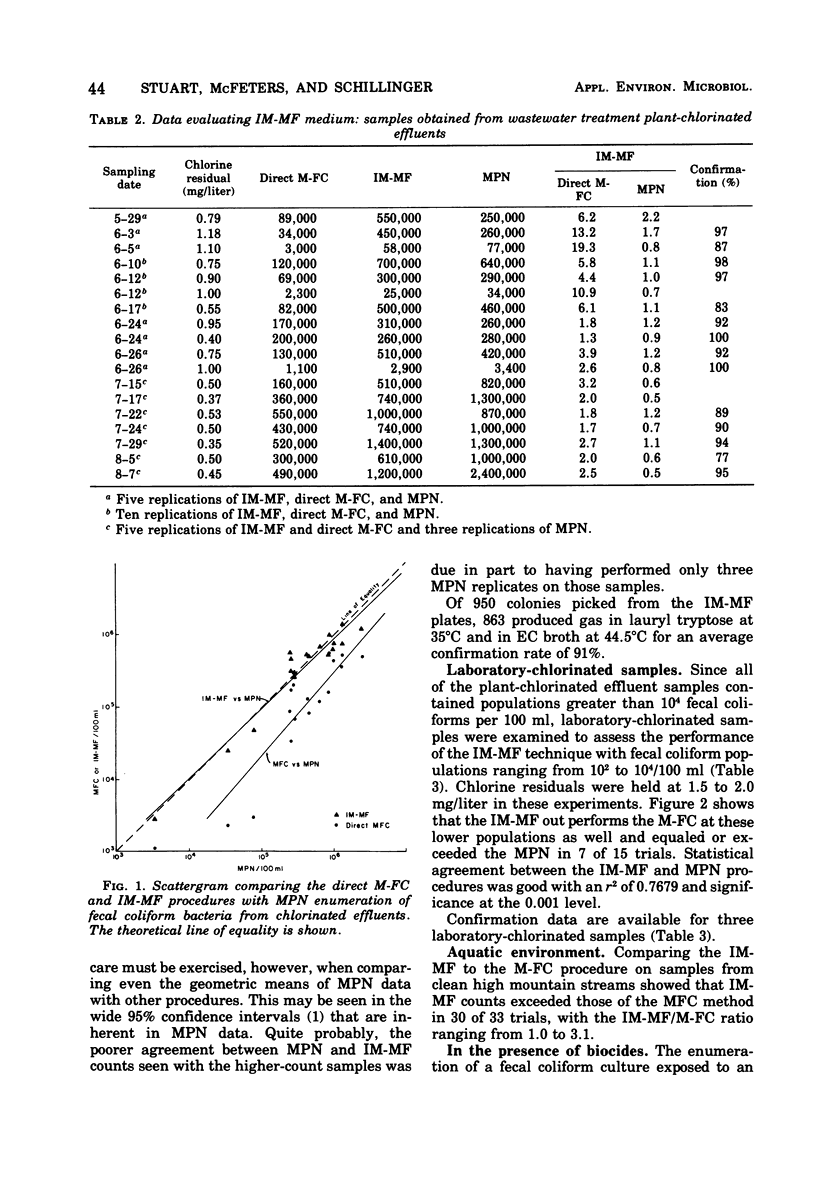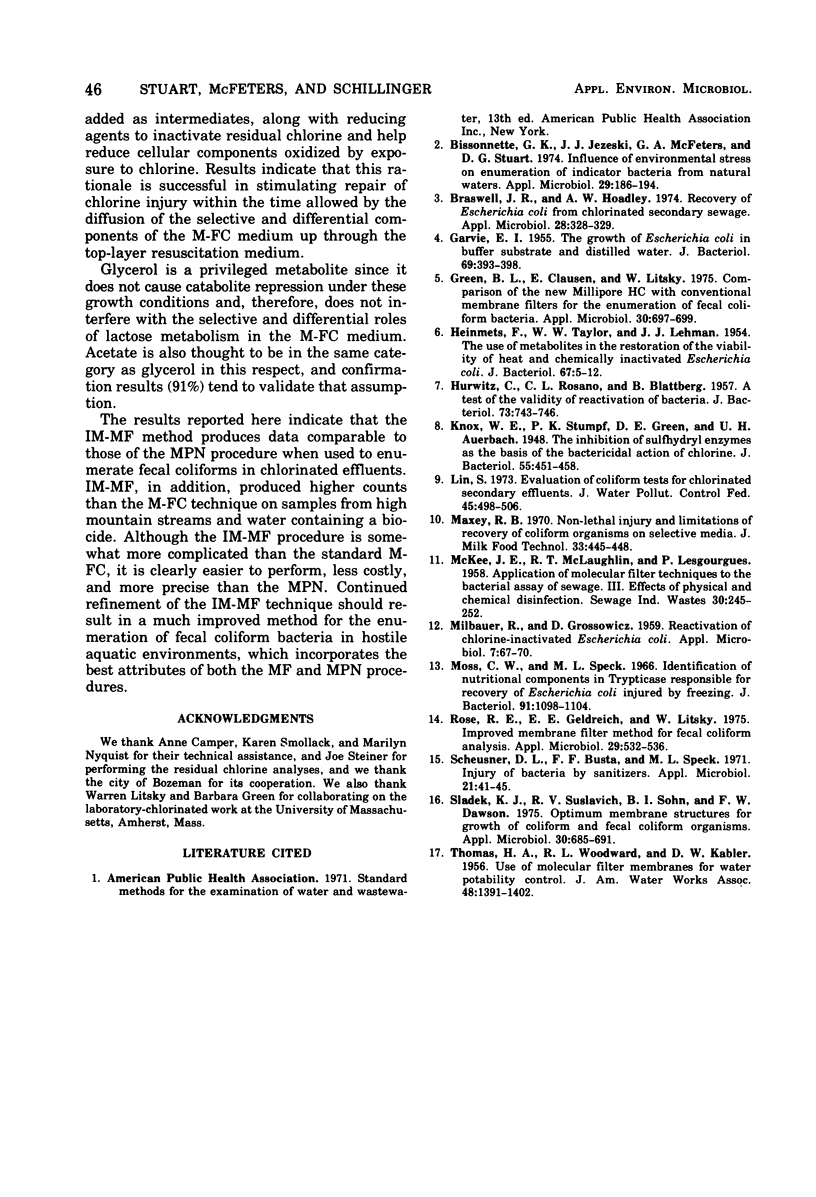Abstract
A two-layer membrane filtration (MF) medium (injury-mitigating MF [IM-MF]) and a procedure for the enumeration of injured fecal coliforms are described. These procedures included the addition of glycerol and acetate plus reducing agents to both layers of a two-layer medium and rinsing of the filter with a rich resuscitation medium. Some changes in incubation time and temperatures were used. This method was compared with the multiple-tube fermentation most-probable-number procedure and the one-step M-FC agar-membrane filter method (direct M-FC) in terms of fecal coliform recovery from various aquatic environments that cause bacterial injury. With chlorinated sewage effluents, results of the IM-MF technique were equal to or greater than the most probable number in 9 of 18 trials and were 1.3 to 19 times greater than the M-FC method. When sewage samples were chlorinated in the laboratory, fecal coliform counts with IM-MF equaled or exceeded the most probable number in 7 of 15 trials and always exceeded the M-FC. M-FC was exceeded by IM-MF in 30 of 33 trials with clean mountain stream water. Fecal coliform bacteria that were exposed to low levels of an iodophore in the laboratory produced IM-MF counts 3 to 10 times greater than those with M-FC. A biochemical rationale for the formation of the IM-MF medium is discussed.
Full text
PDF




Selected References
These references are in PubMed. This may not be the complete list of references from this article.
- Bissonnette G. K., Jezeski J. J., McFeters G. A., Stuart D. G. Influence of environmental stress on enumeration of indicator bacteria from natural waters. Appl Microbiol. 1975 Feb;29(2):186–194. doi: 10.1128/am.29.2.186-194.1975. [DOI] [PMC free article] [PubMed] [Google Scholar]
- Braswell J. R., Hoadley A. W. Recovery of Escherichia coli from chlorinated secondary sewage. Appl Microbiol. 1974 Aug;28(2):328–329. doi: 10.1128/am.28.2.328-329.1974. [DOI] [PMC free article] [PubMed] [Google Scholar]
- GARVIE E. I. The growth of Escherichia coli in buffer substrate and distilled water. J Bacteriol. 1955 Apr;69(4):393–398. doi: 10.1128/jb.69.4.393-398.1955. [DOI] [PMC free article] [PubMed] [Google Scholar]
- Green B. L., Clausen E., Litsky W. Comparison of the new millipore HC with conventional membrane filters for the enumeration of fecal coliform bacteria. Appl Microbiol. 1975 Oct;30(4):697–699. doi: 10.1128/am.30.4.697-699.1975. [DOI] [PMC free article] [PubMed] [Google Scholar]
- HEIMETS F., TAYLOR W. W., LEHMAN J. J. The use of metabolites in the restoration of the viability of heat and chemically inactivated Escherichia coli. J Bacteriol. 1954 Jan;67(1):5–12. doi: 10.1128/jb.67.1.5-12.1954. [DOI] [PMC free article] [PubMed] [Google Scholar]
- HURWITZ C., ROSANO C. L., BLATTBERG B. A test of the validity of reactivation of bacteria. J Bacteriol. 1957 Jun;73(6):743–746. doi: 10.1128/jb.73.6.743-746.1957. [DOI] [PMC free article] [PubMed] [Google Scholar]
- Knox W. E., Stumpf P. K., Green D. E., Auerbach V. H. The Inhibition of Sulfhydryl Enzymes as the Basis of the Bactericidal Action of Chlorine. J Bacteriol. 1948 Apr;55(4):451–458. [PMC free article] [PubMed] [Google Scholar]
- Lin S. Evaluation of coliform tests for chlorinated secondary effluents. J Water Pollut Control Fed. 1973 Mar;45(1):498–506. [PubMed] [Google Scholar]
- MILBAUER R., GROSSOWICZ N. Reactivation of chlorine-inactivated Escherichia coli. Appl Microbiol. 1959 Mar;7(2):67–70. doi: 10.1128/am.7.2.67-70.1959. [DOI] [PMC free article] [PubMed] [Google Scholar]
- Moss C. W., Speck M. L. Identification of nutritional components in trypticase responsible for recovery of Escherichia coli injured by freezing. J Bacteriol. 1966 Mar;91(3):1098–1104. doi: 10.1128/jb.91.3.1098-1104.1966. [DOI] [PMC free article] [PubMed] [Google Scholar]
- Rose R. E., Geldreich E. E., Litsky W. Improved membrane filter method for fecal coliform analysis. Appl Microbiol. 1975 Apr;29(4):532–536. doi: 10.1128/am.29.4.532-536.1975. [DOI] [PMC free article] [PubMed] [Google Scholar]
- Scheusner D. L., Busta F. F., Speck M. L. Injury of bacteria by sanitizers. Appl Microbiol. 1971 Jan;21(1):41–45. doi: 10.1128/am.21.1.41-45.1971. [DOI] [PMC free article] [PubMed] [Google Scholar]
- Sladek K. J., Suslavich R. V., Sohn B. I., Dawson F. W. Optimum membrane structures for growth of coliform and fecal coliform organisms. Appl Microbiol. 1975 Oct;30(4):685–691. doi: 10.1128/am.30.4.685-691.1975. [DOI] [PMC free article] [PubMed] [Google Scholar]


